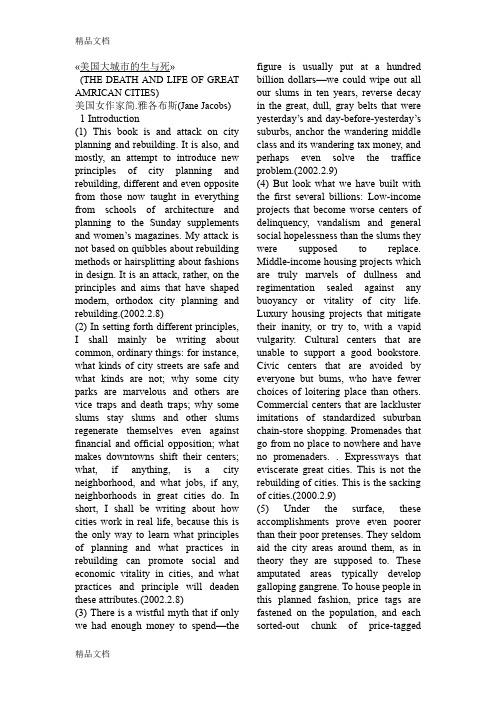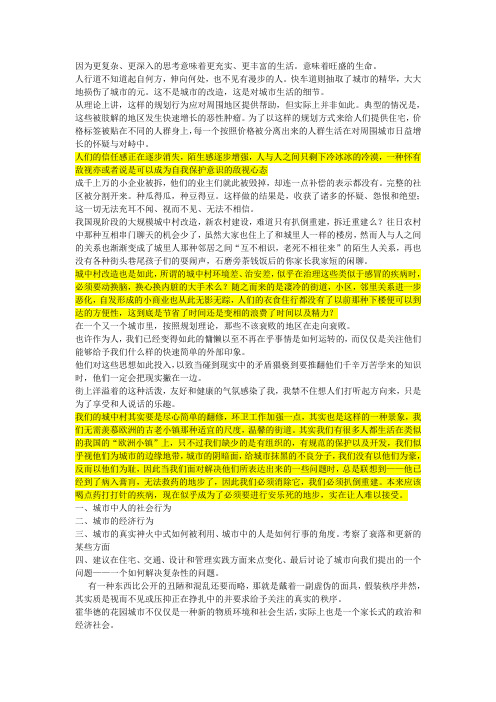美国大城市的死与生最终版
美国大城市的死与生概要

导言作者简明阐述了过去三个城市规划的所谓正统理论,并且指出各理论和实践的问题,对其进行了批判,挑战了长久以来行政者、资本家和规划者对城市建设的理论,提出城市规划治理的核心是城市内部诸要素相互联系的运行机制,规划建设应让城市内部运作达到和谐,而并非单纯注重城市的外在表现。
(花园城市:外围被农业带包围,工业部署在规定区域内,学校、住宅区、绿化带放在生活区,城市公共中心区域里是商业、俱乐部和文化设施。
小城及其绿化带在整体上由一个公共当局控制,城市在其领导下,避免土地使用投机化和所谓非理性变化,消除人口密度增长的企图,人口控制在30000以内。
霍华德认为处理城市功能的方法是分离或分类全部的简单的用途,并以相对的自我封闭的方式来安排这些用途。
)第一部分城市的特性一人行道用途:安全二人行道用途:交往三人行道用途:孩子的同化维护城市的安全是一个城市的街道和人行道的根本任务。
一个成功的城市地区的基本原则是人们在街上身处陌生人之间时必须能感到人身安全,必须不会潜意识感觉受到陌生人的威胁。
造成这种恐惧的野蛮行为或现实而不是想象中的不安全现象不能只归咎于贫民区。
也不能把这个问题归咎于城市的老区。
文明和安全的程度是大不相同的。
不安全这个问题不能通过分散人群,降低稠密度,用郊区的特征来取代城市的特征的方法来解决。
在公共空间与私人空间之间必须要界线分明,不能像郊区的住宅区那样混合在一起。
必须要有一些眼睛盯着街道,(建筑物)它们必须面向街面,不能背向街面,使街道失去保护的眼睛。
人行道上必须总有行人,这样既可以增添看着街面的眼睛的数量,也可以吸引更多的人从楼里往街上看。
从表面上看,我们似乎有一些简单明确的目标:确保街道上的公共空间明确无误,与私人的或什么也不是的空间划清真正的界线。
这样,那些需要监视的地方就会有一个清楚、适用的范围。
另外就是要确保这些公共街道地带有人在监视,并尽量持续不断。
满足这种监视的条件是要在沿着人行道的边上三三两两地布置足够数量的商业点和其他公共场所,尤其是晚上或夜间开放的一些商店和公共场所。
城市消亡记录

城市消亡记录1.废弃之城:布里夫维尔布里夫维尔被称作“废弃之城”,曾是美国科罗拉多州的一个繁荣的煤矿城市。
19世纪末,布里夫维尔因煤矿业的发展而繁荣起来,成为了美国西部的重要经济中心。
然而,随着20世纪的到来,煤矿业的衰落导致了布里夫维尔的衰落。
煤矿业的萎缩使得城市的经济发展遭受重创,大量的居民离开了这座城市,导致了房屋和商业建筑的空置。
如今,布里夫维尔已成为一座废弃之城,只有少数居民居住在这里,大部分地区已经被荒废。
2.自然灾害:废弃之城——普罗玛蒂克普罗玛蒂克曾是意大利南部的一个繁荣的城市,但在17世纪末遭受了一次可怕的地震袭击后,这座城市已经被废弃。
地震导致了城市大部分建筑的倒塌,许多居民不得不撤离,并在其他地方重新开始他们的生活。
尽管有些人试图重建这座城市,但由于地质灾害频发,城市的繁荣已经成为历史的遗迹。
如今,普罗玛蒂克成为一座废弃之城,它的残骸成为了历史和地质学研究的宝贵资源。
3.环境污染:废弃之城——普安弗兰斯普安弗兰斯曾是法国的一个著名的工业城市,但由于环境污染问题,这座城市已经被废弃。
20世纪初,普安弗兰斯是法国的钢铁工业中心,城市的经济以及人口都得到了快速的增长。
然而,在工业化进程中,城市的环境遭受了严重的破坏,大气污染、水污染以及土壤污染严重影响了居民的生活质量。
由于环境污染问题长期得不到解决,大量居民离开了这座城市,使得普安弗兰斯逐渐成为一座废弃之城。
4.战争破坏:废弃之城——科尔科瓦科尔科瓦曾是克罗地亚的一个繁华的港口城市,但在克罗地亚独立战争中遭受了重大的破坏,这座城市已经被废弃。
科尔科瓦作为克罗地亚的港口城市,在独立战争中遭受了塞尔维亚军队的严重轰炸,许多建筑被摧毁,大量的居民被迫逃离。
尽管战争结束后,一些居民试图重建这座城市,但由于经济发展的滞后以及大量建筑的损毁,科尔科瓦已经无法再次成为一个繁华的城市,只能成为一座废弃之城。
5.经济衰退:废弃之城——底特律底特律曾是美国汽车工业的中心,但随着汽车工业的衰退,这座城市已经被废弃。
美国大城市的生长与消亡内容提要

美国大城市的生长与消亡简·雅各布斯主要内容自1961年出版以来,这本书即成为城市研究和城市规划领域的经典名作,对当时美国有关都市复兴和城市未来的争论产生了持久而深刻的影响。
作者以纽约、芝加哥等美国大城市为例,深入考察了都市结构的基本元素以及它们在城市生活中发挥功能的方式,挑战了传统的城市规划理论,使我们对城市的复杂性和城市应有的发展取向加深了理解,也为评估城市的活力提供了一个基本框架。
作者简介简·雅各布斯(1916-2006),出生于美国宾夕法尼亚州斯克兰顿,早年做过记者、速记员和自由撰稿人,1952年任《建筑论坛》助理编辑。
在负责报道城市重建计划的过程中,她逐渐对传统的城市规划观念发生了怀疑,并由此写作了《美国大城市的死与生》一书。
1968年迁居多伦多,此后她在有关发展的问题上扮演了积极的角色,并担任城市规划与居住政策改革的顾问。
1974年成为加拿大公民。
她的著作还有《城市经济学》(1969)、《分离主义的问题。
(1980)、,城市与国家的财富》(1984)、《生存系统》(1993)。
目录导言 (1)第一部分城市的特性 (023)一人行道的用途:安全 (025)二人行道的用途:交往 (048)三人行道的用途:孩子的同化 (066)四街区公园的用途 (079)五城市街区的用途 (100)第二部分城市多样化的条件 (127)六产生多样性的因素 (129)七主要用途混合之必要性 (137)八小街段之必要 (161)九老建筑之必要 (170)十密度之需要 (182)十一有关多样性的一些神话 (201)第三部分衰退和更新的势力 (217)十二多样性的自我毁灭 (219)十三交界真空带的危害 (234)十四非贫民区化和贫民区化 (246)十五渐次性资金和急剧性资金 (267)第四部分不同的策略 (291)十六对住宅的资助 (293)十七被蚕食的城市与对汽车的限制 (309)十八视觉秩序:局限性和可能性 (341)十九拯救和利用廉租住宅区 (360)二十地区管理和规划 (372)二十一城市的问题所在 (393)致谢 (412)索引 (414)。
读书笔记——读《美国大城市的死与生》

读书笔记——读《美国大城市的死与生》第一篇:读书笔记——读《美国大城市的死与生》读书笔记——读《美国大城市的死与生》【摘要】:本文为看规划界的著作《美国大城市的死与生》一书后的读书心得。
文章对《美国大城市的死与生》的写作背景、作者简.雅各布斯的情况进行了简单综述;进而对书本中4个部分的主要内容及观点进行了解读;此外,描述了此书对笔者所产生的一些启示及思考,并用书中的方法分析了笔者曾经生活了五年的城市——广州的一些典型公共空间。
1.《美国大城市的死与生》的写作背景1961年,简.雅各布斯出版了她的名著《美国大城市的死与生》(The Death and Life of Great American Cities)。
这本书产生的时代背景,可以追溯到第二次世界大战后西方工业化国家开始出现的人口生育高峰,并由此带来的一系列对基础设施和社会服务的需求。
就美国而言,城镇化进程继续加快,大都会地区进一步形成,原有的、以开发建设为主体的综合规划体系及其理论在新的需求冲击下不知所措。
伴随着郊区的发展,美国大城市普遍出现了城市中心区衰败的现象。
面对“规划师们”采用传统现代城市规划和重建改造正统理论的原则来解决城市更新和改造的问题,作者站在一个普通公众或社会工作者的立场,通过自己的观察与思考,对现代城市规划和城市建设进行了猛烈的抨击,并提出了一些基于社会和经济考虑的城市规划思想。
2.作者简介本书作者:简.雅各布斯Jacobs, Jane(1916-2006)简·雅各布斯1916年生于美国宾夕法尼亚州一个小镇斯克兰顿,她家族中几代女子都与男性一样拥有职业,而且大多数是教师。
在她的家庭中女孩和男孩被同等对待,家族的这一传统塑造了她果敢而特立独行的性格。
中学毕业后雅各布斯不愿去上大学,在接受了一段时间的速记员培训后,她却去了当地的一家报纸《斯克兰顿论坛》做义务记者。
经济大萧条时期她去了纽约,为时尚杂志《Vogue》撰稿。
《美国大城市的死与生》

《美国大城市的死与生》
钟广丽
【期刊名称】《建筑技艺》
【年(卷),期】2006(141)006
【摘要】《美国大城市的死与生》不只是一本探讨现代城镇规划的书,这是一本
关于城市——城市的生命、城市的经济的书。
这本书自1961年出版以来.就成
为城市研究和城市规划领域的经典名作。
在书中,简·雅各布斯并非从专业规划师
的角度,而是以一个普通市民的角度,用眼睛,用直觉,用心灵观察她所在的城市,并提出一些问题:什么使得街道安全或不安全,什么样的城市才是充满活力的,什么使得城市的多样性面临自我毁灭.为什么有的街区仍然贫困而有些却获得新生与活力?这些问题确实足以令踌躇满志的现代城市的规划师发以深省。
【总页数】1页(P32)
【作者】钟广丽
【作者单位】无
【正文语种】中文
【中图分类】TU984
【相关文献】
1.《美国大城市的死与生》对我国城市发展启示研究 [J], 梁敏
2.当下中国需要怎样的城市--再读《美国大城市的死与生》有感 [J], 朱凯;隆垚;王嘉
3.关于城市街区人行道功能的认识--读《美国大城市的死与生》有感 [J], 易秋丽;许可
4.《美国大城市的死与生》书评 [J], 黄江松
5.《美国大城市的死与生》读后感 [J], 毛彦琪
因版权原因,仅展示原文概要,查看原文内容请购买。
美国大城市的死与生 PPT

目 录
1 2 3 4
城市的特性
城市多样化的条件 衰退和更新的势力 不同的策略
人行道
人行道的用途
1
安全
3
2
交往
孩子的同化
安全
城市安全
• 城市公共区域的安宁—人行道和街道的安宁,不是主要由 警察来维持的,尽管这是警察的责任。它主要是由一个互 相连接的、非正式的网络来维持的,这是一个有着自觉的 抑制手段和标准的网络,由人们自行产生,也由其强制执 行。 • 不安全这个问题不能通过分散人群,降低稠密度,用郊区
结果三
一
长长的大街改成单行道 乘客原本不需要走,ห้องสมุดไป่ตู้在需 要走两条街
三
停车库不断增加,城市 被蚕食
十分感谢各位的聆听
的特征来取代城市的特征的方法解决。
城市安全与监视机制
“眼睛” ”芭蕾艺术”
“眼睛”—— 街道的天然居住者
共识
一条经常被使用的街道应该是一条安全的街道,一条废弃 的街道很可能是不安全的。
对付陌生人
公共空间与私人空间界限分明;有一些“眼睛”盯着街道; 人行道上必须有行人
条件
沿着人行道边上三三两两地布置着足够数量的商业点和其 他公共场所
• 而1954年《联邦住宅法》则针对城市中心衰落的局势,要求对住 区进行重建,并提出了“城市更新”的口号。 • 20世纪50年代~60年代,圣保罗“城市中心重建”、 华盛顿 “西南区计划”、 旧金山“金门计划” 等一系列的城市更新, 都以大规模的拆迁和清除为主。大规模的城市土地开发虽然表面 上带来了城市中心区的繁荣,但由于抬高了城市中心区的地价, 再加上高强度开发带来的交通堵塞、环境恶化等一系列问题,致 使城市中心的吸引力下降。更为严重的是,大规模的城市更新运 动消灭了城市现存的邻里和社区,使城市的社会经济结构遭到破 坏,产生了大量的社会矛盾。
美国大城市的生与死(中英文)

美国大城市的生与死(中英文)«美国大城市的生与死»(THE DEATH AND LIFE OF GREAT AMRICAN CITIES)美国女作家简.雅各布斯(Jane Jacobs)1 Introduction(1) This book is and attack on city planning and rebuilding. It is also, and mostly, an attempt to introduce new principles of city planning and rebuilding, different and even opposite from those now taught in everything from schools of architecture and planning to the Sunday supplements a nd women’s magazines. My attack is not based on quibbles about rebuilding methods or hairsplitting about fashions in design. It is an attack, rather, on the principles and aims that have shaped modern, orthodox city planning and rebuilding.(2002.2.8)(2) In setting forth different principles, I shall mainly be writing about common, ordinary things: for instance, what kinds of city streets are safe and what kinds are not; why some city parks are marvelous and others are vice traps and death traps; why some slums stay slums and other slums regenerate themselves even against financial and official opposition; what makes downtowns shift their centers; what, if anything, is a city neighborhood, and what jobs, if any, neighborhoods in great cities do. In short, I shall be writing about how cities work in real life, because this is the only way to learn what principles of planning and what practices in rebuilding can promote social and economic vitality in cities, and what practices and principle will deaden these attributes.(2002.2.8)译文:介绍(1)这是一本抨击现今城市规划和改造的书。
美国大城市的死与生

目录
01
02
城市的特性
城市多样化
01
城市的特性
人行道 街区公园 城市街区
人行道——安全
维护城市的安全是一个城市的街道和人行道的根本任务。
街道/人行道——
城市 的印象器官
sidewalk
警察?
陌生人多
一个成功的城市地区:人们在街 上身处陌生人之间时必须能感到 人身安全。必须不会潜意识感觉 受到陌生人的威胁
普遍出现了城市中心区衰败的现象。面对
“规划师们”采用传统现代城市规划和重 建改造正统理论的原则来解决城市更新和 改造的问题。
本书框架
城市的特性
人行道
街区公园的用途
城市街区的用途
01
安全
交往
孩子的同化
城市多样化的条件
02
用途混合
产生多样性的因素
有关多样性的一些神话
小街段
老建筑
密度
引发思索?
真正的城市规划到底是什么?理论与实际的对立怎么取舍?
方
街区公园
维护城市的安全是一个城市的街道和人行道的根本任务。
街区公园
费城
富兰克林
1
里顿豪斯
是一个用途广泛、人人喜爱、 非常成功的公园;时尚街区的 中心。
2
城市贫民流浪者聚集的公园,吸引 着肮脏的人,整个街区已经上了动 迁的日程表。
3
赏心悦目的休闲胜地?
华盛顿
Or
犯罪场所的温室?
佩恩
4
最初为恶人的聚集地公园,后 被拆除重新设计,改为办公中 心。
主要用途混合
哈得孙的“街头芭蕾”
第一种多样性:首要用途
VS
1、地区以及尽可能多的内部区域的 主要功能必须要多于一个,最好是多
(完整版)《美国大城市的死与生》读书笔记

qwertyuiopasdfghjklzxcvbnmqwerty uiopasdfghjklzxcvbnmqwertyuiopasd fghjklzxcvbnmqwertyuiopasdfghjklzx cvbnmqwertyuiopasdfghjklzxcvbnmq wertyuiopasdfghjklzxcvbnmqwertyuiopasdfghjklzxcvbnmqwertyuiopasdfghjklzxcvbnmqwertyuiopasdfghjklzxcv bnmqwertyuiopasdfghjklzxcvbnmqw ertyuiopasdfghjklzxcvbnmqwertyuio pasdfghjklzxcvbnmqwertyuiopasdfgh jklzxcvbnmqwertyuiopasdfghjklzxcvb nmqwertyuiopasdfghjklzxcvbnmqwe rtyuiopasdfghjklzxcvbnmqwertyuiop asdfghjklzxcvbnmqwertyuiopasdfghj klzxcvbnmrtyuiopasdfghjklzxcvbnmq wertyuiopasdfghjklzxcvbnmqwertyui opasdfghjklzxcvbnmqwertyuiopasdfg hjklzxcvbnmqwertyuiopasdfghjklzxcv The Death and Life of Great American Cities美国大城市的死与生 读书笔记一、作者简介及写作原因:简·雅各布斯(1916-2006)1916年出生于美国宾夕法尼亚州斯克兰顿,早年做过记者、速记员和自由撰稿人,1952年任《建筑论坛》助理编辑。
在负责报道城市重建计划的过程中,她逐渐对传统的城市规划观念发生了怀疑,并由此写作了《美国大城市的死与生》一书。
1968年迁居多伦多,此后她在有关发展的问题上扮演了积极的角色,并担任城市规划与居住政策改革的顾问。
美国大城市的生与死

此文是对当下城市规划和重建理论的抨击。
同时,更主要的也是尝试引介一些城市规划和重建的新原则,这些原则与现在被教授的那些东西——从建筑和规划的流派到周末增刊以及女性杂志——不同,甚至相反。
我所进行的抨击不是对重建改造方法的一些不痛不痒的批评,或对城市设计形式的吹毛求疵。
恰恰相反,我要抨击的是那些统治现代城市规划和重建改造正统理论的原则和目的。
在叙述不同的原则时,我主要要讲述一些普通的、平常的事情,比如,什么样的街道是安全的,什么样的不是;为什么有的城市花园赏心悦目,而有的则是藏污纳垢之地和死亡陷阱;为什么有的贫民区永远是贫民区,而有的则在资金和官方的双重压力下仍旧能自我更新;什么使得城市中心迁移了它们的位置,什么(姑且言之)是城市的街区,在大城市中,即便有的话,街区应该承担什么样的工作。
简而言之,我将讲述城市在真实生活中是怎样运转的,因为在城市改造中这是知晓何种规划、何种实践能够促进社会和经济的活力,何种实践、何种原则将窒息城市特性的惟一方式。
有一种一相情愿的神话,那就是,只要我们拥有足够的金钱——金钱的数目通常以数千亿美元计——那么我们就能在十年内消除所有的贫民区,在那些空旷的、毫无生气的灰色地带——它们在过去和过去的过去曾是郊区——扭转衰败的趋势,为那些四处观望的中产阶级找到一个家,为他们找到一个缴税的地方,也许甚至还能够解决交通问题。
但是请看看我们用最初的几十亿建了些什么:低收入住宅区成了少年犯罪、蓄意破坏和普遍社会失望情绪的中心,这些住宅区原本是要取代贫民区,但现在这里的情况却比贫民区还要严重。
中等收入住宅区则是死气沉沉、兵营一般封闭,毫无城市生活的生气和活力可言,真正让人感到不可思议。
那些奢华的住宅区域试图用无处不在的庸俗来冲淡它们的乏味;而那些文化中心竟无力支持一家好的书店。
市政中心除了那些游手好闲者以外无人光顾,他们除了那儿无处可去。
商业中心只是那些标准化的郊区连锁店的翻版,毫无生气可言。
美国大城市的生与死

作者简介
• 简· 雅各布斯(1916-2006) 过去半个世纪中对美国乃至世 界城市规划发展影响最大的人 士之一 她写的《美国大城市 的死与生》震撼了当时的美国 规划界这本书终结了五十年代 美国政府以铲除贫民窟和兴建 高速路为特征的大规模的城市 更新运动
多样性 复杂性 自然化第四部分源自Part 4不同的策略
对住宅的资助、 被蚕食的城市与对汽车的限制 视觉秩序局限性可能性、 拯救和利用廉租住宅区、 地区的管理和规划、 地区的管理和规划
对住宅的资助
现行的政府对城市住宅的资助存在 很多弊端,不仅把人按收入按收入 划分到一个封闭的区域,而且政府 亲自负责这些项目,容易忽视城市 的运作方法,这对城市的建设毫无 关系。
地区的管理和规划
大城市的城市管理和规划很复杂,但是现 在采取的方法却是按照管理一个小城市 或是小城镇的方法和体制来放大,这完 全无益与大城市的管理,就其对实际问 题的了解还有各部门的沟通都非常困难。
城市的问题所在
城市运作是个有复杂性问题,但是规划师,政府 并没有意识到这点,所以城市规划这个领域到 了停滞不前的地步。最后,作者重申:单调、 缺乏活力的城市只能是孕育自我毁灭的种子。 但是,充满活力,多样化和用统计中的城市孕 育的则是自我再生的种子,及时有问题的需要 超出了城市的限度,他们也有足够的力量延续 这种再生能力并最终就绝那些问题个需求。
在城市里,街道能够提供主要视觉景致, 可以通过两种方法引进视觉变化,1.在 街道互相分得很开的地方增加更多的街 道。2.在缺少非规整和视觉这段的地方 引入视觉遮断。
拯救和利用廉租住宅区
把生机引入一个廉价住宅以及与其接壤的 交界处使其能够加入整个地区,在此之前 规划者必须要进行诊断和分析,该地区是 缺少哪一种生发多样性的条件,并抓住一 切机会将这种缺失补上。
(整理)《美国大城市的生与死》....

«美国大城市的生与死»(THE DEATH AND LIFE OF GREAT AMRICAN CITIES)美国女作家简.雅各布斯(Jane Jacobs)1 Introduction(1) This book is and attack on city planning and rebuilding. It is also, and mostly, an attempt to introduce new principles of city planning and rebuilding, different and even opposite from those now taught in everything from schools of architecture and planning to the Sunday supplements and women’s magazi nes. My attack is not based on quibbles about rebuilding methods or hairsplitting about fashions in design. It is an attack, rather, on the principles and aims that have shaped modern, orthodox city planning and rebuilding.(2002.2.8)(2) In setting forth different principles,I shall mainly be writing about common, ordinary things: for instance, what kinds of city streets are safe and what kinds are not; why some city parks are marvelous and others are vice traps and death traps; why some slums stay slums and other slums regenerate themselves even against financial and official opposition; what makes downtowns shift their centers; what, if anything, is a city neighborhood, and what jobs, if any, neighborhoods in great cities do. In short, I shall be writing about how cities work in real life, because this is the only way to learn what principles of planning and what practices in rebuilding can promote social and economic vitality in cities, and what practices and principle will deaden these attributes.(2002.2.8)(3) There is a wistful myth that if only we had enough money to spend—the figure is usually put at a hundred billion dollars—we could wipe out all our slums in ten years, reverse decay in the great, dull, gray belts that were yesterday’s and day-before-yesterday’s suburbs, anchor the wandering middle class and its wandering tax money, and perhaps even solve the traffice problem.(2002.2.9)(4) But look what we have built with the first several billions: Low-income projects that become worse centers of delinquency, vandalism and general social hopelessness than the slums they were supposed to replace. Middle-income housing projects which are truly marvels of dullness and regimentation sealed against any buoyancy or vitality of city life. Luxury housing projects that mitigate their inanity, or try to, with a vapid vulgarity. Cultural centers that are unable to support a good bookstore. Civic centers that are avoided by everyone but bums, who have fewer choices of loitering place than others. Commercial centers that are lackluster imitations of standardized suburban chain-store shopping. Promenades that go from no place to nowhere and have no promenaders. . Expressways that eviscerate great cities. This is not the rebuilding of cities. This is the sacking of cities.(2000.2.9)(5) Under the surface, these accomplishments prove even poorer than their poor pretenses. They seldom aid the city areas around them, as in theory they are supposed to. These amputated areas typically develop galloping gangrene. To house people in this planned fashion, price tags are fastened on the population, and each sorted-out chunk of price-taggedpopulace lives in growing suspicion and tension against the surrounding city. When two or more such hostile islands are juxtaposed the result is called “a balanced neighborhood.” Monopolistic shopping centers and monumental cultural centers cloak, under the public relations hoohaw, the subtraction of commerce, and of culture too, from the intimate and casual life of cities.(2002.2.10)(6) That such wonders may be accomplished, people who get marked with the planners’ hex signs are pushed about, expropriated, and uprooted much as if they were the subjects of a conquering power. Thousands of small businesses are destroyed, and their proprietors ruined, with hardly a gesture at compensation. Whole communities are torn apart and sown to the winds, with a reaping of cynicism, resentment and despair that must be heard and seen to be believed.A group of clergymen in Chicago, appalled at the fruits of planned city rebuilding there, ask,(7) Could job have been thinking of Chicago when he wrote:(8) Here are men that alter their neighbor’s landmark…shoulder the poor aside, conspire to oppress the friendless.(9) Reap they the field that is none of theirs, strip they the vineyard wrongfully seized from its owner… (10) A cry goes up from the city streets, where wounded men lie groaning… (11) If so, he was also thinking of New York, Philadelphia, Boston, Washington, St. Louis, San Francisco and a number of other places. The economic rationale of current city rebuilding is a hoax. The economics of city rebuilding do not rest soundly on reasoned investment of public tax subsides, as urban renewal theory proclaims, but also on vast, involuntary subsides wrung out of helpless site victims. And the increased tax returns from such sites, accruing to the cities as a result of this“investment,” are a mirage, a pitifulgesture against the ever increasing sums of public money needed to combat disintegration and instability that flow from the cruelly shaken-up city. The means to planned city rebuilding are as deplorable as the end.(2002.2.12)(12)Meantime, all the art and science of city planning are helpless to stem decay—and the spiritlessness that precedes decay—in ever more massive swatches of cities. Nor can this decay be laid, reassuringly, to lack of opportunity to apply the arts of planning. It seems to matter little whether they are applied or not. Consider the Morningside Heights area in New York City. According to planning theory it should not be in trouble at all, for it enjoys a great aboudance of parkland, campus, playground and pleasant ground with magnificent river views. It is a famous educational center with splendid institutions—Columbia University, Union Theological Seminary, the Juilliard School of Music, and half a dozen others of eminent respectability. It is the beneficiary of good hospitals and churches. It has no industries. Its streets are zoned in the main against “incompatible uses “i ntruding into the preserves for solidly constructed, roomy, middle-and upper-classapartments. Yet by the early 1950’s Morningside Heights was becoming a slum so swiftly, the surly kind of slum in which people fear to walk the streets, that the situation posed a crisis for the institutions. They and the planning arms of the city government got together, applied more planning theory, wiped out the most run-down part of the area and built in its stead a middle-income housing project complete with shopping center, and a public housing project, all interspersed with air, light, sunshine and landscaping. This was hailed as a great demonstration in city saving.(13)After that, Morningside Heights went downhill even faster.(14)Nor is this an unfair or irrelevant example. In city after city, precisely the wrong areas, in the light of planning theory, are decaying. Less noticed, but equally significant, in city after city the wrong areas, in the light of planning theory, are refusing to decay.(15)Cities are an immense laboratory of trial and error, failure and success, in city building and city design. This is the laboratory in which city planning should have been learning and forming and discipline (if such it can be called) have ignored the study of success and failure in real life, have been incurious about the reasons for unexpected success, and are guided instead by principles derived from the behavior and appearance of towns, suburbs, tuberculosis sanatoria, fairs, and imaginary dream cities—from anything but cities themselves.(2002.2.13)(16) If it appears that the rebuilt portions of cities and the endless new developments spreading beyond the cities are the reducing city and countryside alike to a monotonous, unnourishing gruel, this is not strange, It all comes, first-, second- third- or fourth-hand, out of the same intellectual dish or mush, a mush in which the qualities, necessities, advantages and behavior of great cities have been behavior of other and more inert types of settlements.(17) There is nothing economically or socially inevitable about either the decay of old cities or the fresh-minted decadence of the new unurban urbanization. On the contrary no other aspect of our economy and society has been more purposefully manipulated for a full quarter of a century to achieve precisely what we are getting. Extraordinary governmental financial incentives have been require to achieve this degree of monotony, sterility and vulgarity. Decades of preaching, writing and exhorting by experts have gone into convincing us and our legislators that mush like this must be good for us, as long as it comes bedded with grass.(18)Automobiles are often conveniently tagged as the villains responsible for the ills of cities and the disappointments and futilities of city planning. But the destructive effect s of automobiles are much less a cause than a symptom of our incompetence at city building. Of cause planners, including the highwaymen with fabulous sums of money and enormous power at their disposal, are at a loss to make automobiles and cities compatible with one another. They do not know what to do with automobiles in cities because they do not know howto plan for workable and vital cities anyhow—with or without automobiles.(19)The simple needs of automobiles are more easily understood and satisfied than the complex needs of cities, and a growing number of planners and designers have come to believe that if they can only solve the problems of traffic, they will thereby have solved the major problem of cities. Cities have much more intricate economic and social concerns than automobile traffic. How can you know what to try with traffic until you know how the city itself works, and what else it needs to do with its streets? You can’t.(2002.2.15)(20)It may be that we have became so feckless as people that we no longer care how things do work, but only what kind of quick, easy outer impression they give. If so, there is little hope for our cities or probably for much else in our society. But I do not think this is so.(2002.2.16)(21)Specifically, in the case of planning for cities, it is clear that a large number of good and earnest people do care deeply about building and renewing. Despite some corruption, and considerable greed for the other man’s vineyard, the inte ntions going into the messes we make are, on the whole, exemplary. Planners, architects of city design, and those they have led along with them in their beliefs are not consciously disdainful of the importance of knowing how things work. On the contrary, they have gone to great pains to learn what the saints and sages of modern orthodox planning have said about how cities ought to work and what ought to be good for people and businesses in them. They take this with such devotion that when contradictory reality intrudes, threatening to shatter their dearly won learning, they must shrug reality aside.(2002.2.17) (22)Consider, for example, the orthodox planning reaction to a district called the North End in Boston. This is an old, low-rent area merging into the heavy industry of the waterfront, and it is officially considered Boston’s worst slum and civic shame. It embodies attributes which all enlightened people know are evil because so many wise men have said they are evil. Not only is the North End bumped right up against industry, but worse still it has all kinds of working places and commerce mingled in the greatest complexity with its residences. It has the highest commerce mingled in the greatest complexity with its residences. It has the highest concentration of dwelling nits, on the land that is used for dwelling units, of any part of Boston, and indeed one of the highest concentrations to be found in any American city. It has little parkland. Children play in the streets. Instead of super-blocks or even decently large blocks, it has very small blocks; in planning parlance it is “badly cut up with wasteful streets.” Its buildings are old. Everything conceivable is presumably wrong with the North End. In orthodox planning terms, it is a three-dimensional textbook of “megalopolis” in the last stages of depravity. The North End is thus a recurring assignment for M.I.T. and Harvard planning and architectural students, who now and again pursue,under the guidance of their teachers, the paper exercise of converting it into super-blocks and park promenades, wiping away its nonconforming uses, transforming it to an ideal of order and gentility so simple it could be engraved on the head of a pin.(23)When I saw the North End again in 1959, I was amazed at the change. Dozens and dozens of buildings had been rehabilitated. Instead of mattresses against the windows there were Venetian blinds and glimpses of fresh paint. Many of the small, converted houses now had only one or two families in them instead of the old crowded three or four. Some of the families in the tenements (as I learned later, visiting inside) had uncrowded themselves by throwing two older apartments together, and had equipped these with bathrooms, new kitchens and the like. I looked down a narrow alley, thinking to find at least here the old, squalid North End, but no: more neatly repointed brickwork, new blinds, and a burst of music as a door opened. Indeed, this was the only city district I had ever seen—or have seen to this day—in which the sides of buildings around parking lots had not been left raw and amputated, but repaired and painted neatly as if they were intended to be seen. Mingled all among the buildings for living were an incredible number of splendid food stores, as well as such enterprises as upholstery making, metal working, carpentry, food processing. The streets were alive with children playing, people shopping, people strolling, people talking. Had it not been a cold January day, there would surely have been people sitting.(24)The general street atmosphere of buoyancy, friendliness and good health was so infectious that I began asking directions of people just for the fun of getting in on some talk. I had seen a lot of Boston in the past couple of days, most of it sorely distressing, and this struck me, with relief, as the healthiest place in the city. But I could not imagine where the money had come from for the rehabilitation, because it is almost impossible today to get any appreciable mortgage money in districts of American cities that are not either high-rent, or else imitations of suburbs. To find out, I went into a bar and restaurant (where an animated conversation about fishing was in progress) and called a Boston planner I know.(25)“Why in the world are you downi n the North End?” he said. “Money? Why, no money or work has gone into the North End. Nothing’s going on down there. Eventually, yes, but not yet. That’s a slum!”(26)“It doesn’t seem like a slum in the city. It has two hundred and seventy-five dwelling units to the net acre! I hate to admit we have anything like that in Boston, but it’s a fact.” (27)“Do you have any other figures on it?” I asked.(28)“Yes, funny thing. It has among the lowest delinquency, disease and infant mortality rates in the city. It also has the lowest ratio of rent to income in the city. Boy, are those people getting bargains. Let’s see . . . the child population is just about average for the city, on the nose. The death rate is low, 8.8 per thousand, against the average city rate of 11.2.The TB death rate is very low, less than 1 per ten thousand, can’t understand it, it’ slower eventhan Brookline’s. In the old days the North End used to be the city’s worst spot for tuberculosis, but all that has changed. Well they must be strong people. Of course it’s a terrible slum.”(29)“You should have more slums like this,” I said.“ Don’t tell me there are plans to wipe this out. You ought to be down here learning as much as you can from it.”(30)“I know how you feel,” he said.“ I often go down there myself just to walk around the streets and feel that wonderful, cheerful street life. Say, what you ought to do, you ought to come back and go down in the summer if you think it’s fun now. You ‘d be crazy about it in summer. But of course we have to rebuild it eventually. We’ve got to get those people off the streets.” (2002.2.18)(31)Here was a curious thing .My friend’s instincts told him the North End was a good place, and his social statistics confirmed it. But everything he learned as a physical planner about what is good for people and food for city neighborhoods, everything that made him an expert, told him the North End had to be a bad place. (32)The leading Boston savings banker, “a man ’way up there in the power structure ,” to whom my friend referred me for my inquiry about the money, confirmed what I learned, in the meantime, from people in the North End . The money had not come now knows enough about planning to know a slum as well as the planners do. “No sense in lending money into the North End,” the banker said. “It’s a slum! It’s still getting some immigrants! Furthermore, back in the Depression it had a very large number of foreclosures; bad record.” (I had heard about this too, in the meantime, and how families had worked and pooled their resources to buy back some of those foreclosed buildings.)(33)The largest mortgage loans that had been fed into this district of some 15,000 people in the quarter-century since the Great Depression were for $3,000, the banker told me, “and very, very few of those.” The rehabilitation work had been almost entirely financed by business and housing earnings within the district, plowed back in, and by skilled work bartered among residents and relatives of residents.(34)By this time I knew that this inability to borrow for improvement was a galling worry to North Enders, and that furthermore some North Enders were worried because it seemed impossible to get new building in the area except at the price of seeing themselves and their community wiped out in the fashion of the students’ dreams of a city Eden, a fate which they knew was not academic because it had already smashed completely a socially similar—although physically more spacious—nearby district called the West End. They were worried because they were aware also that patch and fix with nothing else could not do forever. “Any chance of loans for new construction in the. North End?” I asked the banker.(35)“No, absolutely not!” he said, sounding impatient at my denseness. “That’s a slum!”(36)Bankers, like planners, have theories about cities on which they act.They have gotten their theories from the same intellectual sources as the planners. Bankers and government administrative officials who guarantee mortgages do not invent planning theories nor, surprisingly, even economic doctrine about cities. They are enlightened nowadays, and they pick up their ideas from idealists, major new ideas for considerably more than a generation, theoretical planners, financers and bureaucrats are all just about even today.(37)And to put it bluntly, they are all in the same stage of elaborately learned superstition as medical science was early in the last century, when physicians put their faith in bloodletting , to draw out the evil humors which were believed to cause disease. With bloodletting, it took years of learning to know precisely which veins, by what rituals, were to be opened for what symptoms. A superstructure of technical complication was erected in such deadpan detail that the literature still sounds almost plausible. However, because people, even when they are thoroughly enmeshed in descriptions of reality which are at variance with reality, are still seldom devoid of the powers of observation and independent thought, the science of bloodletting, over most of its long sway, appears usually to have been tempered with a certain amount of common sense. Or it was tempered until it reached its highest peaks of technique in, of all places, the young United States. Bloodletting went wild here.It had an enormously influential proponent in Dr. Benjamin Rush, still revered as the greatest statesman-physician of our revolutionary and federal periods, and a genius of medical administration. Dr. Rush Got Things Done. Among the things he got done, some of them good and useful, were to develop, practice, teach and spread the custom of bloodletting in cases where prudence or mercy had heretofore restrained its use. He and his students drained the blood of very young children, of consumptives, of the greatly aged, of almost anyone unfortunate enough to be sick in his realms of influence. His extreme practices aroused the alarm and horror of European bloodletting physicians. And yet as late as 1851, a committee appointed by the State Legislature of New York solemnly defended the thoroughgoing use of bloodletting. It scathingly ridiculed and censured a physician, William Turner, who had the temerity to write a pamphlet criticizing Dr. Rush’s doctrines and calling “the prac tice of taking blood in diseases contrary to common sense, to general experience, to enlightened reason and to the manifest laws of the divine Providence.” Sick people needed fortifying, not draining, said Dr. Turner, and he was squelched(38)Medical analogies, applied to social organisms, are apt to be farfetched, and there is no point in mistaking mammalian chemistry for what occurs in a city. But analogies as to what goes on in the brains of earnest and learned men, dealing with complex phenomena they do not understand at all and trying to make do with a pseudoscience, do have point. At in the pseudoscience of bloodletting,just so in the pseudoscience of city rebuilding and planning, years of learning and a plethora of subtle and complicated dogma have arisen on a foundation of nonsense. The tools of technique have steadily been perfected. Naturally, in time, forceful and able men, admired administrators, having swallowed the initial fallacies and having been provisioned with tools and with public confidence or mercy might previously have forbade. Bloodletting could heal only by accident or insofar as it broke the rules, until the time when it was abandoned in favor of the hard, complex business of assembling, using and testing, bit by bit, true descriptions of reality drawn not from how it ought to be, but from how it is. The pseudoscience of city planning and its companion, the art of city design, have not yet broken with the specious comfort of wishes, familiar superstitions, oversimplifications, and symbols, and have not yet embarked upon the adventure of probing the real world.(39)So in this book we shall start, if only in a small way, adventuring in the real world, ourselves. The way to get at what goes on in the seemingly mysterious and perverse behavior of cities is, I think, to look closely, and with as little previous expectation as is possible, at the most ordinary scenes and events, and attempt to see what they mean and whether any threads of principle emerge among them. This is what I try to do in the first part of this book.(40)One principle emerges so ubiquitously, and in so many and such complex different forms, that I turn my attention to its nature in the second part of this book, a part which becomes the heart of my argument. This ubiquitous principle is the need of cities for a most intricate and close-grained diversity of uses that give each other constant mutual support, both economically and socially. The components of this diversity can differ enormously, but they must supplement each other in certain concrete ways.(41)I think that unsuccessful city areas are areas which lack this kind of intricate mutual support, and that the science of city planning and the are of city design, in real life for real cities, must become the science and art of catalyzing and nourishing these close-grained working relationships. I think, from the evidence I can find, that there are four primary conditions required for generating useful great city diversity, and that by deliberately inducing these four conditions, planning can induce city vitality (something that the plans of planners alone, and the designs of designers alone, can never achieve). While Part I Is principally about the social behavior of people in cities, and is necessary for understanding what follows, Part II is principally about the economic behavior of cities and is the most important part of this book.(42)Cities are fantastically dynamic places, and this is striking true of their successful parts, which offer a fertile ground for the plans of thousands of people. In the third part of this book, I examine some aspects of decay and regeneration, in the light of how cities are used, and how they and their people behave, in real life.(43)The last part of the book suggests changes in housing, traffic, design, planning and administrative practice, and discusses, finally the kind of problem which cities pose—a problem in handling organized complexity. (44)The look of things and the way they work are inextricably bound together, and in no place more so than cities. But people who are interested only in how a city “ought” to look and uninterested in how it works will be disappointed by this book. It is futile to plan a city’s appearance, or speculate on how to endow it with a pleasing appearance of order, without knowing what sort of innate, functioning order it has. To seek for the look of things as a primary purpose or as the main drama is apt to make nothing but trouble. (45)In New York’s East Harlem there is a housing project with a conspicuous rectangular lawn which became an object of hatred to the project tenants.A social worker frequently at the project was astonished by how often the subject of the lawn came up, usually gratuitously as far as she could see, and how much the tenants despised it and urged that it be done away with. When she asked why, the usual answer was, “What good is it?” or “Who wants it?” Finally one day a tenant more articulate than the others made this pronouncement: “Nobody cared what we wanted when they built this place. They threw our houses down and pushed us here and around here to get a cup of coffee or a newspaper even, or borrow fifty cents. Nobody cared what we need. But the big men come and look at that grass and say, ‘Isn’t it wonderful! Now the poor have everything!” (46)This tenant was saying what moralists have said for thousands of years: Handsome is as handsome does. All that flitters is not gold.(47)She was saying more: There is a quality even meaner than outright ugliness or disorder, and this meaner quality is the dishonest mask of pretended order, achieved by ignoring or suppressing the real order that is struggling to exist and to be served. (48)In trying to explain the underlying order of cities, I use a preponderance of examples from New York because that is where I live. But most of the basic ideas in this book come from things I first noticed or was told in other cities. For example, my first inkling about the powerful effects of certain kinds of functional mixtures in the city came from Pittsburgh, my first speculations about street safety from Philadelphia and Baltimore, my first notions about the meanderings of downtown from Boston, my first clues to the unmaking of slums from Chicago. Most of the material for these musings was at my own front door, but perhaps it is easiest to see things first where you don’t take them for granted. The basic idea, to try to begin understanding the intricate social and economic order under the seeming disorder of cities, was not my idea at all, but that of William Kirk, head worker of Union Settlement in East Harlem, New York, who, by showing me East Harlem, showed me a way of seeing other neighborhood, and down-towns too. In every case, I have tried to test out what I saw or heard in one city or neighborhood against others, to find how relevant each city’s。
美国大城市的死与生(60周年致敬版)

要实现城区功用的多样性,必须同时满足四个条件:必须有两种以上主要使用功能,小街区,不同年代的旧 建筑的同时存在,足够的人口密度。
城市规划的第一要旨在于,如何实现多种功用的混合,为各种功用提供足够的空间。城市功用的丰富多样性, 才使城市有了活力,城市文明才得以延续和繁荣。
具有上世纪中叶的时代特征与美国文化背景特征。
精彩摘录
城市的本质在于其多样性,城市的活力来源于多样性,城市规划的目的在于催生和协调多种功用,来满足不 同人的多样而复杂的需求
那就是它反证了:离开了人,城市便毫无意义,城市的生命和活力来源于活生生的人!这样一个简单的道理, 我们的一些城市管理者和决策者却似乎并不理解。
城市逐渐被清晰地理解为一个系统,有着复杂的结构和丰富多样的功能,它们之间是相互关联、相互作用的; 而城市规划是一个建立在对城市的理解基础上的、系统的调控过程;它是城市中复杂关系和不同人群利益的协调 过程,更多的是一个政治过程,绝不是一个纯技术的过程;规划不是以技术蓝图为终结,而是一个多解的过程和 一个不断根据系统的反馈进行调整的、动态的城市管治过程。
美国大城市的死与生(60周 年致敬版)
读书笔记模板
01 思维导图
03 读书笔记 05 目录分析
目录
02 内容摘要 04 精彩摘录 06 作者介绍
思维导图
本书关键字分析思维导图
都市
可能性
美国大城市美国街区大城市城市
雅各布斯 城市
局限性
版
多样性
廉租
用途
现代
部分
建筑
内容摘要
美国大城市的死与生

美国大城市的死与生
美国大城市的死与生是指在这些城市中的居民的生命和死亡现象。
在美国大城市,生活和死亡是紧密相连的。
这些城市拥有繁忙的人口和经济活动,因此也伴随着各种健康和社会问题。
以下是一些关于美国大城市死与生的主要方面:
1. 平均寿命:美国大城市的平均寿命通常高于全国平均水平。
这部分是因为大城市提供更好的医疗设施和服务,以及更多的机会获得高质量的教育和就业。
2. 健康风险:大城市的生活方式可能增加患病的风险。
空气污染、职业压力、不健康的饮食和缺乏锻炼等因素可能导致疾病,并对人们的生命健康产生负面影响。
3. 犯罪率:美国大城市一般有更高的犯罪率,这可能增加
人们在城市中受伤或死亡的风险。
暴力犯罪、枪支暴力和
车祸等都可能导致生命的丧失。
4. 医疗设施:美国大城市通常拥有先进的医疗设施和专业
人员。
人们可以获得更好的医疗服务,从而提高生命的质
量和预期寿命。
5. 社会压力:大城市的快节奏生活和竞争环境可能导致人
们面临更多的压力。
这种压力可能对人们的身心健康产生
负面影响,并可能增加自杀率。
总之,美国大城市的死与生是一个复杂的议题,涉及诸多
因素。
尽管大城市提供了更多的机会和便利,但也存在各
种健康和社会问题,可能影响人们的预期寿命和生活质量。
美国大城市的生与死(中英文)

美国大城市的生与死(中英文)«美国大城市的生与死»(THE DEATH AND LIFE OF GREAT AMRICAN CITIES)美国女作家简.雅各布斯(Jane Jacobs)1 Introduction(1) This book is and attack on city planning and rebuilding. It is also, and mostly, an attempt to introduce new principles of city planning and rebuilding, different and even opposite from those now taught in everything from schools of architecture and planning to the Sunday supplements a nd women’s magazines. My attack is not based on quibbles about rebuilding methods or hairsplitting about fashions in design. It is an attack, rather, on the principles and aims that have shaped modern, orthodox city planning and rebuilding.(2002.2.8)(2) In setting forth different principles, I shall mainly be writing about common, ordinary things: for instance, what kinds of city streets are safe and what kinds are not; why some city parks are marvelous and others are vice traps and death traps; why some slums stay slums and other slums regenerate themselves even against financial and official opposition; what makes downtowns shift their centers; what, if anything, is a city neighborhood, and what jobs, if any, neighborhoods in great cities do. In short, I shall be writing about how cities work in real life, because this is the only way to learn what principles of planning and what practices in rebuilding can promote social and economic vitality in cities, and what practices and principle will deaden these attributes.(2002.2.8)译文:介绍(1)这是一本抨击现今城市规划和改造的书。
美国大城市的死与生第四组

东哈姆莱姆社区
界限要分明
在公共空间与私人空间之间必须要界限 分明,不能像郊区的住宅区那样混在一起; 否则就会产生令人苦恼的结果:要么选择 共享所有,要么什么也不共享。因为大家 都不想一个陌生人随便地就卷入自己的私 生活
关于城市街道安全与交往 小结
• 如何发挥城市街道安全与交往? <一>私人公共空间界限要分明; • <二>要有监视的眼睛; • <三>要有值得信赖的公共人物。
城市安全问题维护
要维护城市的安全首先要 明白的是,城市公共区域的安 宁——人行道和街道的安全— —主要由一个互相关联的,非 正式的网络来维持的【这是一 个有着自觉的抑制手段和标准 的网络,由人们自觉产生,也 由其强制执行】
第二件事要明白的事事, 不安全这个问题不能通过分散 人流,降低密度,用郊区的特 征来取代城市的特征的方法来 解决。洛杉矶就是这样一个鲜 明的例子
在陌生人较多的情况下, 保证城市安全的城市街道必须 具备以下三个条件:<1>在公 共空间与私人空间之间必须要 界限分明,不能像郊区的住宅 区那样混在一起; <2>必须要有一些眼睛盯 着街道,这些眼睛属于我们成 为街道天然居住者; <3>人行道上必须总有行 人,这样可以增添看着街面的 眼睛的数量,也可以吸引更多 的人从楼上往街上看。
街道——促进城市交往
•
大城市人们之间的交往一般不会在私下进行,而是通过一些公众人物 去促进这种交往,但前提便是人们对这些公众人物有一种信任感,否则 就不可能被实现。东哈莱姆社区里卢里就是一个成功公众人物的代表: 在朝向四十一公立学校路边的一个拐角处指导一些小孩子横穿马路,这 是他经常做的一件事,因为他觉得此事非常有必要。他将一把雨伞借给 一个顾客,借一元钱给另一位顾客,接过了别人要求保管的两把钥匙, 让隔壁楼里要外出的几个人把他们的几件行李搁在他店里,向两个问他 要香烟的年轻人教训了几句,又为几个人指路,替另外一个人保管一块 表,以便晚些时候街对面的修理匠开门时把表给他,告诉几个打听租房 的人有关在这个街区租房的各种价格的信息,倾听一个人向他叙述他家 中发生的困难事,给对方很多安慰,正告几个小混混,他们不能到这个 地方来,除非他们表现良好,并且告诉他们什么是良好的行为,为到他 店里来买一些小商品的顾客提供进行六七场谈话的临时场所,为那些常 来的顾客分理新到的报纸和杂志,他们会来这里取这些报刊,向一位来 买生日礼物的母亲建议不要买那种船模型,因为一个去参加同样生日晚 会的孩子会拿出这样一份礼物,在送报人到来时,从多余的报纸里找出 一份前几天的过期报纸(这是给我准备的)。
美国大城市的死与生

美国大城市的死与生简·雅各布斯第五章城市街区的用途01其一贯的“反动”观点:1. 要反掉传统的、以公共设施服务距离为基准的街区设置方法(7000人街区).2. 反对传统的内向的、“温馨的”、封闭的街区观念――城市的最大优越性之一就是“流动”!3. 反对在设计中以乡村或者小城镇为模板来设计大城市。
大城市有着大城市的优越性,和小型聚落(乡村和小城镇)是完全不同并且应该是不同的因为这样才能够互补)。
“广泛的选择和丰富的机会不正式城市所要提供的吗?”中心问题:街区是干什么的?街区是日常的自治机构――自治本地化――街区的必要性――街区的本质街区是必要的,但是反对伪街区。
作者认为的三种必须的、有用的街区(我想其英文应该是zoning,是说明的一种分区制):1. 作为一个整体的城市2. 街道为主的街区3. 大城市中的地区(约为100,000的“城中之城”)其中:1.“城市”级别:应该能够形成一些特殊利益集团“20~30个性情相投(同一个圈子)的朋友”、“他希望他的朋友们知道他在说什么。
”“一个城市的整体性表现在能够将有着共同兴趣的人集拢在一起”,这个是城市的最大的可用资源之一。
2.“街区”――街道为主的街区能够形成公共监视网――街道自治功能的最重要体现另一功能:在不可能自我解决的问题上寻求外界帮助街区的大小――“这个问题完全没有意义”。
街区成功的一个很大原因是依赖于各个街区之间的互相交错和重合――街区组――产生多样性、带来变化(视觉上、经济上)。
3.地区其主要功能是“协调”作用,协调城市和街道之间的关系,作为了一种“中介”。
街区,必须“反”隔绝雅各布斯认为的理解城市的思维角度:1)对过程的考虑。
2)从归纳推导的角度来考虑问题,从点到面,从具体到整体,而不是相反。
(从局部到整体,从小到大。
)3)寻找一些“非平均”的线索,这些线索会包括一些非常小的变数,正式这些小的变数会展现大的和更加“平均”的变数活动方式。
美国大城市的死与生Word 文档

因为更复杂、更深入的思考意味着更充实、更丰富的生活。
意味着旺盛的生命。
人行道不知道起自何方,伸向何处,也不见有漫步的人。
快车道则抽取了城市的精华,大大地损伤了城市的元。
这不是城市的改造,这是对城市生活的细节。
从理论上讲,这样的规划行为应对周围地区提供帮助,但实际上并非如此。
典型的情况是,这些被肢解的地区发生快速增长的恶性肿瘤。
为了以这样的规划方式来给人们提供住宅,价格标签被贴在不同的人群身上,每一个按照价格被分离出来的人群生活在对周围城市日益增长的怀疑与对峙中。
人们的信任感正在逐步消失,陌生感逐步增强,人与人之间只剩下冷冰冰的冷漠,一种怀有敌视亦或者说是可以成为自我保护意识的敌视心态成千上万的小企业被拆,他们的业主们就此被毁掉,却连一点补偿的表示都没有。
完整的社区被分割开来。
种瓜得瓜,种豆得豆。
这样做的结果是,收获了诸多的怀疑、怨恨和绝望;这一切无法充耳不闻、视而不见、无法不相信。
我国现阶段的大规模城中村改造,新农村建设,难道只有扒倒重建,拆迁重建么?往日农村中那种互相串门聊天的机会少了,虽然大家也住上了和城里人一样的楼房,然而人与人之间的关系也渐渐变成了城里人那种邻居之间“互不相识,老死不相往来”的陌生人关系,再也没有各种街头巷尾孩子们的耍闹声,石磨旁茶钱饭后的你家长我家短的闲聊。
城中村改造也是如此,所谓的城中村环境差、治安差,似乎在治理这些类似于感冒的疾病时,必须要动换脑,换心换内脏的大手术么?随之而来的是凄冷的街道,小区,邻里关系进一步恶化,自发形成的小商业也从此无影无踪,人们的衣食住行都没有了以前那种下楼便可以到达的方便性,这到底是节省了时间还是变相的浪费了时间以及精力?在一个又一个城市里,按照规划理论,那些不该衰败的地区在走向衰败。
也许作为人,我们已经变得如此的慵懒以至不再在乎事情是如何运转的,而仅仅是关注他们能够给予我们什么样的快速简单的外部印象。
他们对这些思想如此投入,以致当碰到现实中的矛盾猥亵到要推翻他们千辛万苦学来的知识时,他们一定会把现实撇在一边。
- 1、下载文档前请自行甄别文档内容的完整性,平台不提供额外的编辑、内容补充、找答案等附加服务。
- 2、"仅部分预览"的文档,不可在线预览部分如存在完整性等问题,可反馈申请退款(可完整预览的文档不适用该条件!)。
- 3、如文档侵犯您的权益,请联系客服反馈,我们会尽快为您处理(人工客服工作时间:9:00-18:30)。
Page
怎么促进人们的交往了呢?
人 行 道 的 用 途 交 往
人行道生活的 社会结构部分 依赖于那些可 谓自我任命的 公共人物。
成为公共人物 的一个条件是 他应该处于公 共生活中,他 能够与很多不 同的人交往。
店主等常是街 道上的公共人 物,另外还有 一些特殊的。
公共人物
成为条件
街道店主
3、人行道的用途:孩子们的同化 很多孩子们肯定要在城市的街道上玩耍的。
-----洛杉矶的例子
美国大城市的死与生
人 行 道 的 用 途 安 全
洛杉矶几乎已经完全郊区化了。它已没有 真正意义上的可以称得上是人口密度高的城市 地区了。但是就像别的城市一样,洛杉矶不能 避开这个事实,即作为一个城市,它拥有很多 陌生人,他们中总有一些人会带来麻烦。洛杉 矶的犯罪数字可以让人目瞪口呆。在17个人口 高于1000000的标准都市地区中,洛杉矶的犯 罪率高居榜首。
4、街区公园
一般来说,街区公园或公园样的空敞地被认为是给予城市贫困人口的恩惠。 让我们把这个想法颠倒一下,把城市的公园视为是一些“贫困的地方”,需 要生气与欣赏的恩惠。这种看法与现实更加相符,因为事实是人们赋予了公 园用途并且使其成功地发挥了作用——或反之:拒绝使用,公园由此被废弃 或不能发挥作用。
美国大城市的死与生
如何能保证安全? 人 行 道 的 用 途 安 全 不是主要由警察来维持的,它主要是由 一个相关联的,非正式的网络来维持的,这 是一个有着自觉的抑制手段和标准的网络, 由人们自行产生也由其强制执行。 不能通过分散人群,降低稠密度的方式 来保证安全。用郊区的特征来取代城市的特 征的方法来解决。
美国大城市的死与生
怎么做到好的公园 ?
街 区 公 园
如果是在市中心,公园的使用者必须包含购 物者,参观者和闲逛者以及在市中心工作的人。 如果不在市中心,公园也应该位于生活内容丰富 多彩的地区,那里有工作、文化、住宅和商业方 面的活动——尽可能拥有城市能够提供的一切。 街区公园规划的一个主要问题归根到底就是如何 培植一个能够使用和支持公园的街区。
内容简介:
《美国大城市的死与生(纪念版)》 自1961年出版以来,即成为城市研究和 城市规划领域的经典名作,对当时美国有关都市复兴和城市未来的争 论产生了持久而深刻的影响。 作者以纽约、芝加哥等美国大城市为例,深入考察了都市结构 的基本元素以及它们在城市生活中发挥功能的方式,挑战了传统的城 市规划理论,使我们对城市的复杂性和城市应有的发展取向加深了理解 也为评估城市的活力提供了一个基本框架。
美国大城市的死与生
有用的街区
三种类型的街区有用
城 市 街 区
的 用 途
1 作为一个整体在城市
2 街道为主的街区
3 大城市中的地区
一个城市的整体性表现在能够把有共同兴趣的人聚拢到一起, 这是城市最大的可用资源之一。
有效的街区应该达到以下目标:
地方应大到足够作为地区来运行。 公园、广场建筑作为街道特性的一部分来使用, 从而强化街道用途的多样化,并将这些用途紧 密地编织在一起。公园广场等的使用不应该各 行其是,互相分离,或与地区内的街区的用途 互不关联。 突出一些地域的功能身份,这些
人行道
街道及其人行道,是城市中的主要公共域,是 一个城市的最重要的器官。试想,当你想到一 个城市时,你脑中出现的是什么?是街道。
美国大城市的死与生
1、人行道的用途:安全
大城市最重要的特点之一就是有着众多的陌生人。 一个成功地区的基本原则是人们在街上身处陌生人之间必须 能感到人身安全,必须不会潜意识感觉受到陌生人的威胁。做 不到这一点的城市地区在其他方面也会同样糟糕,并且会给他 自己,给城市造成沉重如山的麻烦。
人 行 道 的 用 途 孩 子 们 的 同 化
一个记录片制作人的发现:
那些住在拥有人行道生活的老街区的孩子 放学后愿意离开学而另外一半住在新的公共住 宅区的孩子不愿离开学校
美国大城市的死与生
人 行 道 的 用 途 孩 子 们 的 同 化
为什么呢? 因为那些新的公共住宅区经过特定的规划, 住宅区面积极大,草坪遍地,游乐场点缀期间, 却不见街道,而这样的场所也增加的青少年犯 罪,自然也就不安全。
美国大城市的死与生
2、人行道的用途:交往
人的一生肯定都是不断的在和人打交道,所以交往成了 人们不可或缺的社会活动。
人们决意要护卫基本的隐私,但同时 又希望能与周围的人有不同程度上的 接触和互相帮助。 如何获得这种平衡? 存钥匙的例子说明了一条无意识中确 定的平衡线的存在,划出了城市公共 领域与个人隐私领域的界线。
第四部分
5 城市街区的用途
关于街区公园,作者调查了美国大城市的 本章中,作者强调街道的安全不是靠警察来 第一部分写的主要是关于城市中人的社会行为, 众多公园,发现很多大型公园在使用上都缺乏 维持得了的,要从根本上解决街道的安全问题, 多样性,不能吸引各种各样的使用者,没有吸 作者从最容易使人产生共鸣的街道着手,对城市 那么随时都要有无数的“街道眼”(指街道能够吸 引人们自发地使用公园的能力,所以他们实质 引人们关注它,作者把盯着街道的眼睛叫做街道 生活的景象进行了大量的描述,讨论了人行道 上只是流浪汉和罪犯们所呆的场所,成为街区 眼)盯着其所在的街道;另外,街道上要有人活 不安全的因素之一。作者支持在城市中建立一 的用途 :安全、交往、孩子的同化以及街区公 动,作者形象的把某一街道上人们从早到晚的繁 些小型的公园活动,要它们起到小的“必须物品” 忙而有序的和谐的生活场景描会成“街道芭蕾”。 园和城市街区的用途。 的作用。
美国大城市的死与生
为什么?
街 区 公 园
为什么有些城市公园园赏心悦目,有些却令人 心灰意冷,很少有人光顾了? 简雅各布斯认为当时有很少的公园可以随着时 间的推移变得更加可爱和有价值
美国大城市的死与生
街 区 公 园
街区公园的冷清、衰退原因 公园因为周边地区及他本身缺乏多样性,以 及由此导致的单调乏味的气氛而丧失了功能成 为了“残疾者”。其次,公园太多,目的有太 近似,原本具有的活力和多样性也因此消失殆 尽。
城 市 街 区
的 用 途
首先
文字内容
在城市辖域下具有小城市的面 积和力量的地区内尽可能地促 成具有这种特性的街道网。
创造生动有趣的街道
ห้องสมุดไป่ตู้
第一部分 第二部分 第三部分
第二部分主要是关于城市的经 6济行为,是本书最重要的部分。 产生多样性的因素 书中说“城市是由无数个不同 7 主要用途混合之必要性 的部分组成,各个部分也表现出 8无穷的多样化。大城市的多样化 小街段之必要 是自然天成的”。关键是要丰富 9 老建筑之必要 城市的多样性,才能提高城市的 10 密度之必要 活力。作者指出,要想在城市的 街道和地区发生丰富的多样性, 11 有关多样性的一些神话 必须具备四个条件。
美国大城市的死与生
如果一个一般的城市公园不能自发使用公园, 或者获得周边多样性的支持,那么就有必要把公 园从一般性的公园改成有某种特殊功能的公园。
街 区 公 园
美国大城市的死与生
5、城市街区的用途 城市街区的自治功能是组建公共监督网,以此来 保护行人和居民,发展一个小范围的、建立在日常 公共生活基础上的网状关系,建立一种互相信任和 社会监控的机制。当街区的自治功能不能解决问题 的时候,必须能有效地找到帮助。
Page
16
人 行 道 的 用 途 交 往
在纽约,人们常出门把钥 匙放在一些店铺里,让他 们的朋友自己去取,这是 一个很通行的习惯。比如 自己周末离家但朋友要用 自己房子的时候,或家里 人刚巧白天都不在家时, 我们就会告诉这个朋友他 可以到街对面的熟食店取我们家的钥匙。熟食店的老板 通常一次手里头有十几把这样的钥匙。他还有一个专门 抽屉装这些钥匙。为什么会选择熟食店的老板呢,因为 我们信任他,他同时也有副热心肠,而与此同时他不会 处心积虑的关心我们的私事,谁到我们房子里来,他认 为这不是他应该关心的事
美国大城市的死与生
而那些老街区,也就是“街道眼”很多,人来人 往,所以就比那些新的公共住宅区安全的多。
人 行 道 的 用 途 孩 子 们 的 同 化
美国大城市的死与生
人 行 道 的 用 途 孩 子 们 的 同 化
纠正一个片面的观点
那些认为玩需要空地、草地 和雇佣来的保安或监管人员 对孩子来说是必然有利的, 而普通人来往的街道则对孩 子们有害的看法说到底是对 普通人老百姓的深深蔑视。
第一部分 城市的特性(023-100页)
目 录
第二部分 城市多样化的条件(127-201页) 第三部分 衰退和更新的势力(217-267页) 第四部分 不同的策略(291-393页)
第一部分 第二部分 第三部分
1 人行道的用途:安全 2 人行道的用途:交往 3 人行道的用途:孩子的同化 4 街区公园的用途
美国大城市的死与生
人 行 道 的 用 途 安 全
表面上,老城市 或者城市的老区看 起来缺乏秩序,其 实在其背后有一种 神奇的秩序在维持 着街道的安全和城 市的自由——这正 是老城的成功之处。这是一种复杂的秩序。其实 质是城市互相关联的人行道用途,这为它带来了 一个又一个驻足的目光,正是这种目光构成了城 市人行道上的安全监视系统。
美国大城市的死与生
美国大城市的死与生
保证安全的三个条件
公共空间与私人空间之间必须界线分明
条件一
必须要有“街道眼”,这些眼睛属于街道的天然
条件二 居住者
人行道上必须总有人 条件三
达到这种监视条件需要沿人行道布置有足够多的商业点和其他
公共场所,尤其是晚上或夜间开放的一些商店或公共场所。
这些小场所给人们提供了具体的使用人行道的理由。
有些地方本身没有多少吸引力能够成为公共场所,但这些 小场所可以让它们成为通向另外一些地方的必经之路。
